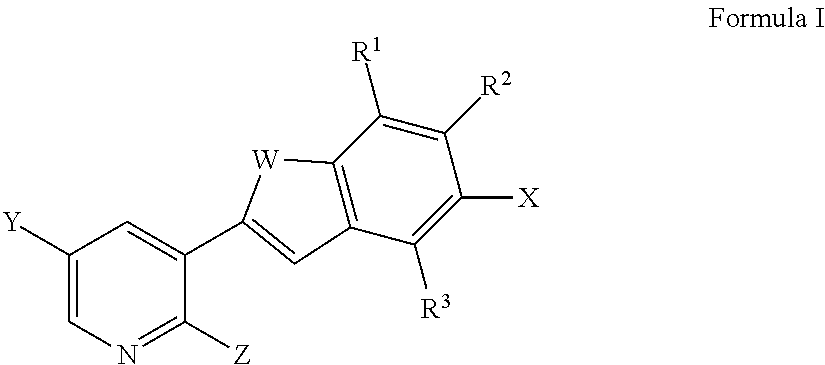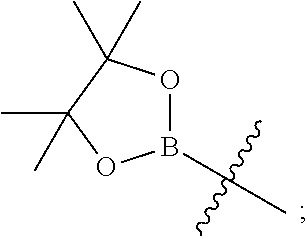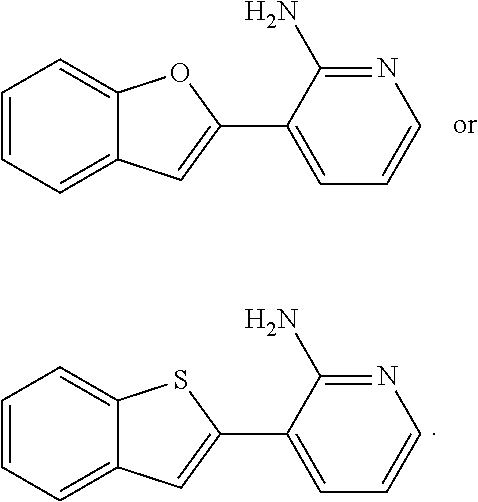Pyridyl benzothiophenes as kinase inhibitors
a technology of pyridyl benzothiophene and kinase inhibitor, which is applied in the direction of biocide, group 5/15 element organic compounds, and 3/13 element organic compounds, etc., can solve problems such as abnormal blood vessel growth
- Summary
- Abstract
- Description
- Claims
- Application Information
AI Technical Summary
Benefits of technology
Problems solved by technology
Method used
Image
Examples
preparation 1
[0340]
tert-butyl {2-[2-amino-5-({[dimethyl(oxido)-λ4-sulfanylidene]amino}carbonyl)pyridin-3-yl]-1-benzothien-5-yl}carbamate
[0341]To the degassed mixture of 6-amino-N-[dimethyl(oxido)-λ4-sulfanylidene]-5-iodonicotinamide (1.19 g, 3.51 mmol, 1 eq), 5-tert-butoxycarbonylaminobenzothiophene-2-boronic acid (1.52 g, 1.15 eq), and aq sodium carbonate (2M, 5.27 mL, 3 eq) in dioxane (7.5 mL) was added Ph3P (184 mg, 0.2 eq) and Pd(OAc)2 (79 mg, 0.1 eq). The mixture was heated to 50° C. with vigorous stirring for 30 minutes. The reaction mixture was then partitioned between aq NH4Cl and EtOAc. The organic layer was isolated, washed with sat aq NaHCO3, brine, and finally dried with anhydrous sodium sulfate. The upper solution was decanted, concentrated, and the foamy oily residue was subject to a gradient column chromatography (EtOAc-Hex 3:1 to 6:1) yielding tert-butyl {2-[2-amino-5-({[dimethyl(oxido)-λ4-sulfanylidene]amino}carbonyl)pyridin-3-yl]-1-benzothien-5-yl}carbamate as a white solid in ...
preparation 2
[0342]
6-amino-5-(5-amino-1-benzothien-2-yl)-N-[dimethyl(oxido)-λ4-sulfanylidene]nicotinamide
[0343]To the mixture of tert-butyl {2-[2-amino-5-({[dimethyl(oxido)-λ4-sulfanylidene]amino}carbonyl)pyridin-3-yl]-1-benzothien-5-yl}carbamate (1.23 g, 2.67 mmol, 1 eq) in dichloromethane (6 mL) at 0° C. was added dropwise trifluoroacetic acid (5.16 mL, 20 eq). During this process the reaction mixture became a brown solution. The reaction was stirred at 0° C. for 15 minutes and then at room temperature for 3 hours. The reaction was partitioned between DCM and cold saturated aq NaHCO3. The organic layer was isolated, washed with brine and dried with anhydrous sodium sulfate. The clear layer was decanted, concentrated, and the brown solid residue was treated with EtOAc. An orange colored solid was obtained upon filtration giving 6-amino-5-(5-amino-1-benzothien-2-yl)-N-[dimethyl(oxido)-λ4-sulfanylidene]nicotinamide in amount of 0.837 g (87%).
example 1
[0344]
6-amino-N-[dimethyl(oxido)-λ4-sulfanylidene]-5-[5-({[(3-methylphenyl)amino]carbonyl}amino)-1-benzothien-2-yl]nicotinamide
[0345]To the solution of 6-amino-5-(5-amino-1-benzothien-2-yl)-N-[dimethyl(oxido)-λ4-sulfanylidene]nicotinamide (72 mg, 0.2 mmol. 1 eq) in anhydrous DMF (2 mL) at room temperature was added dropwise m-tolylisocyanate (0.03 mL, 1.2 eq). After the reaction solution was stirred at rt for 2 hours, it was diluted with EtOAc, washed sequentially with saturated aq NaHCO3, aq NH4Cl, brine, and finally dried with anhydrous sodium sulfate. The organic layer was decanted, concentrated, and the solid residue was triturated with DCM with stirring. A lightly pink solid was obtained upon filtration to yield 6-amino-N-[dimethyl(oxido)-λ4-sulfanylidene]-5-[5-({[(3-methylphenyl)amino]carbonyl}amino)-1-benzothien-2-yl]nicotinamide in amount of 91 mg (92%).
[0346]1H NMR (DMSO-d6) δ: 8.78 (s, 1H), 8.61 (s, 1H), 8.61 (d, J=2.1 Hz, 1H), 8.10 (dd, J=2.1, 0.3 Hz, 1H), 8.02 (d, J=2.1 ...
PUM
| Property | Measurement | Unit |
|---|---|---|
| volume | aaaaa | aaaaa |
| temperature | aaaaa | aaaaa |
| temperature | aaaaa | aaaaa |
Abstract
Description
Claims
Application Information
 Login to View More
Login to View More - R&D
- Intellectual Property
- Life Sciences
- Materials
- Tech Scout
- Unparalleled Data Quality
- Higher Quality Content
- 60% Fewer Hallucinations
Browse by: Latest US Patents, China's latest patents, Technical Efficacy Thesaurus, Application Domain, Technology Topic, Popular Technical Reports.
© 2025 PatSnap. All rights reserved.Legal|Privacy policy|Modern Slavery Act Transparency Statement|Sitemap|About US| Contact US: help@patsnap.com



